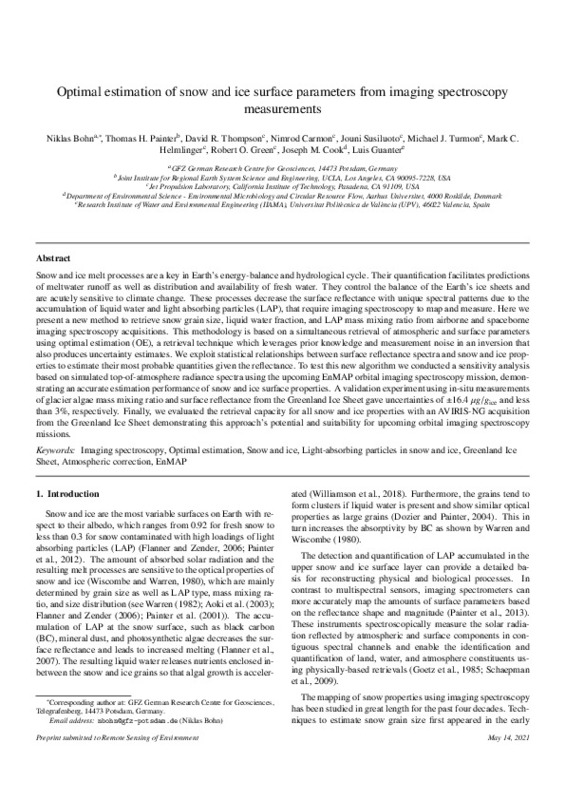Bohn, N.; Painter, TH.; Thompson, DR.; Carmon, N.; Susiluoto, J.; Turmon, MJ.; Helmlinger, MC.... (2021). Optimal estimation of snow and ice surface parameters from imaging spectroscopy measurements. Remote Sensing of Environment. 264:1-19. https://doi.org/10.1016/j.rse.2021.112613
Por favor, use este identificador para citar o enlazar este ítem: http://hdl.handle.net/10251/184453
|
Título:
|
Optimal estimation of snow and ice surface parameters from imaging spectroscopy measurements
|
|
Autor:
|
Bohn, Niklas
Painter, Thomas H.
Thompson, David R.
Carmon, Nimrod
Susiluoto, Jouni
Turmon, Michael J.
Helmlinger, Mark C.
Green, Robert O.
Cook, Joseph M.

 Guanter-Palomar, Luis María
Guanter-Palomar, Luis María
|
|
Entidad UPV:
|
Universitat Politècnica de València. Departamento de Física Aplicada - Departament de Física Aplicada
|
|
Fecha difusión:
|
|
|
Resumen:
|
[EN] Snow and ice melt processes are a key in Earth's energy-balance and hydrological cycle. Their quantification facilitates predictions of meltwater runoff as well as distribution and availability of fresh water. They ...[+]
[EN] Snow and ice melt processes are a key in Earth's energy-balance and hydrological cycle. Their quantification facilitates predictions of meltwater runoff as well as distribution and availability of fresh water. They control the balance of the Earth's ice sheets and are acutely sensitive to climate change. These processes decrease the surface reflectance with unique spectral patterns due to the accumulation of liquid water and light absorbing particles (LAP), that require imaging spectroscopy to map and measure. Here we present a new method to retrieve snow grain size, liquid water fraction, and LAP mass mixing ratio from airborne and spaceborne imaging spectroscopy acquisitions. This methodology is based on a simultaneous retrieval of atmospheric and surface parameters using optimal estimation (OE), a retrieval technique which leverages prior knowledge and measurement noise in an inversion that also produces uncertainty estimates. We exploit statistical relationships between surface reflectance spectra and snow and ice properties to estimate their most probable quantities given the reflectance. To test this new algorithm we conducted a sensitivity analysis based on simulated top-of-atmosphere radiance spectra using the upcoming EnMAP orbital imaging spectroscopy mission, demonstrating an accurate estimation performance of snow and ice surface properties. A validation experiment using in-situ measurements of glacier algae mass mixing ratio and surface reflectance from the Greenland Ice Sheet gave uncertainties of +/- 16.4 mu g/gice and less than 3%, respectively. Finally, we evaluated the retrieval capacity for all snow and ice properties with an AVIRIS-NG acquisition from the Greenland Ice Sheet demonstrating this approach's potential and suitability for upcoming orbital imaging spectroscopy missions
[-]
|
|
Palabras clave:
|
Imaging spectroscopy
,
Optimal estimation
,
Snow and ice
,
Light-absorbing particles in snow and ice
,
Greenland ice sheet
,
Atmospheric correction
,
EnMAP
|
|
Derechos de uso:
|
Reconocimiento - No comercial - Sin obra derivada (by-nc-nd)
|
|
Fuente:
|
Remote Sensing of Environment. (issn:
0034-4257
)
|
|
DOI:
|
10.1016/j.rse.2021.112613
|
|
Editorial:
|
Elsevier
|
|
Versión del editor:
|
https://doi.org/10.1016/j.rse.2021.112613
|
|
Código del Proyecto:
|
info:eu-repo/grantAgreement/EC/H2020/856416/EU
info:eu-repo/grantAgreement/BMWI//50 EE 0850/
info:eu-repo/grantAgreement/UKRI//NE%2FS001034%2F1/
info:eu-repo/grantAgreement/NASA//80NM0018D0004/
|
|
Agradecimientos:
|
This work has been done in the frame of EnMAP, which is funded under the DLR Space Administration with resources from the GermanFederal Ministry of Economic Affairs and Energy (grant No. 50 EE 0850) and contributions from ...[+]
This work has been done in the frame of EnMAP, which is funded under the DLR Space Administration with resources from the GermanFederal Ministry of Economic Affairs and Energy (grant No. 50 EE 0850) and contributions from DLR, GFZ and OHB System AG. Joseph M. Cook was in part supported by a grant from the European Research Council (ERC) under the European Union's Horizon 2020 Research and Inno-vation Programme (ERC Synergy Grant'Deep Purple'; grant agreement No. 856416) and the NERC Standard Grant"MicroMelt", code NE/S001034/1 . We acknowledge the support of a Jet Propulsion Laboratory Advanced Concepts grant. A portion of this research took place at the Jet Propulsion Laboratory, California Institute of Technology, under a contract with the National Aeronautics and Space Administration (80NM0018D0004) .
[-]
|
|
Tipo:
|
Artículo
|







![[Cerrado]](/themes/UPV/images/candado.png)


